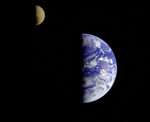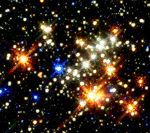Welcome to Mission Night Sky!

Milky Way at Night
Here you will learn about the celestial bodies that you can see at night and how and why the night sky looks the way it does. In cities or where there are lots of lights at night it is hard to see the beauty of the night sky. So, if you can, take a trip to the country or someplace where there are no lights, wait till night, then look up and you will be amazed by what you see. To help you see the objects in the sky better you can use binoculars or a telescope. Use the Understanding the Night Sky handout given to you by your teacher to take notes as you read through this web page and its links.
Planets at Night

Earth and moon
We can see five planets in the night sky they are Mercury, Venus, Mars, Jupiter, and Saturn. These are the planets that are the closest to use. Planets are much closer to earth than are other stars. We are able to see these planets because they reflect the light from the sun. The planets look like they are "wandering" around the constellations sky. This is because they are orbiting the sun at different rates. Planets also don't twinkle the way stars do. If you use binoculars you will be able to see two more planets, Uranus and Neptune and numerous other objects. Using a telescope you can even see Pluto. For a more complete list of what you can see check out this part of the Nine Planets Website.
Twinkle, twinkle little star

Cluster of stars
Stars glow bright in the night sky because they are burning fuel. Stars look like they are twinkling because they are so far away that they are relatively small and as their light is bent by the earth's atmosphere (the atmosphere is different in different spots) so it keeps bending the light which makes it look as though the star is twinkling. This twinkling is called stellar scintillation. Explore these links for more detailed explanations of why stars twinkle: Earth's Sky, The WVHS Planetarium, and Enchanted Learning (Stars),
Constellations
When Ancient people looked up in the sky they saw that the stars looked like they formed the shape of creatures. These patterns are called constellations. There are 88 major constellations that astronomers can identify. The constellations are always grouped together in the same way. But as the earth orbits the sun it changes our view of the sky. So, the constellations appear to move across the sky slowly over time. Therefore, the constellations that we can see changes with the seasons. Although, there are some constellations that we can always see because they are directly above the North Pole. For a detailed explanation of constellations use the Cobb Virtual Library and search World Book or World Book Kids using the word, "constellation." To see what the constellations look like from the Northern Hemisphere (where we live) look at Windows to the Universe. You can also read some of the Ancient Greek Myths of the Night Sky.
Here's a diagram of how the constellations will look tonight from Atlanta:
| Sky map by AstroViewer® |
To see how the night sky looks at different times of the year and from different places try the Astroviewer below.
From AstroViewer
http://www.astroviewer.com/index.html
Night Sky Quiz:
Which planets can be seen at night with just your bare eyes?
A. Mercury, Venus, Mars, Jupiter, and Saturn
B. Mars, Jupiter, Neptune, Uranus,and Pluto
C. Ceres, Eris, Hameau, and Makemake
D. Venus, Mars, Jupiter, and Saturn
Why do stars twinkle?
A. Because they are wiggling in the sky
B. Because they are radiating heat
C. Because they are have shiny surfaces like a diamond and reflect light
D. Because they are so far away that they tiny and their light is bent by the earth's atmosphere
What are the patterns of stars in the night sky called?
A. The Big Dipper
B. Constellation
C. Stelllar scintillations
D. Galaxies
Why do the planets look like they are wandering around in the sky?
A. Because they are rotating at different speeds on their axises
B. Because they are lost in the dark
C. Because their orbit around the sun makes them appear to move in comparison to the constellations
D. Because of the rotation of the earth
Mission: Porquoi Tale: Explaining the Night
Using the Understanding the Night form you completed pick topic to write a story, song, or poem that explains why something in the night sky looks the way it does. Porquoi folktales explain why something is the way it is. The word porquoi means "why" in French. Your teacher will use the Porquoi Story Rubric to grade your project You can read the porquoi story How the Leopard got His Stripes, by Rudyard Kipling, as an example.




